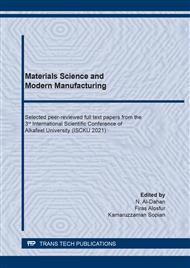[1]
K.S. Novoselov, A.K. Geim, S.V. Morozov, D. Jiang, Y. Zhang, S.V. Dubonos, I.V. Grigorieva, and A. A. Firsov: science, vol. 306, no. 5696, (2004), pp.666-669.
DOI: 10.1126/science.1102896
Google Scholar
[2]
W. Zhang, J. Liu, Y. Sun, S. Gadipelli, X. Han, and G. Colantuono: (2018).
Google Scholar
[3]
J. C. Meyer, A. K. Geim, M. I. Katsnelson, K. S. Novoselov, T. J. Booth, and S. Roth: Nature, vol. 446, no. 7131, (2007), pp.60-63.
DOI: 10.1038/nature05545
Google Scholar
[4]
A. krueger: wily-vch, germany, (2010).
Google Scholar
[5]
S. Iijima, Helical: Nature. Vol 354, (1991).
Google Scholar
[6]
S. Iijima, T. Ichihashi: Nature. Vol 363, (1993).
Google Scholar
[7]
N. Nakashima: Inter. J. Nanosci. Vol 4, (2005).
Google Scholar
[8]
N. Nakashima, T. Fujigaya: Chem. Lett. Vol 36, 692-692, (2007).
Google Scholar
[9]
R.H. Baughman, A.A. Zakhidov, W.A. De Heer: Science. Vol 297, (2002).
Google Scholar
[10]
W. Wang, K.A.S. Fernando, Y. Lin, M.J. Meziani: J. Am. Chem. Soc. Vol 130, (2008).
Google Scholar
[11]
P.L. McEuen, M.S. Fuhrer, H. Park: IEEE Transactions on Nanotechnology. Vol 1, (2002).
Google Scholar
[12]
C.V. Nguyen, Q. Ye, M. Meyyappan: Measur. Sci. Tech. vol 16, (2005).
Google Scholar
[13]
N.M. Gabor, Z. Zhong, K. Bosnick, J. Park, P.L. McEuen: Science. Vol 325, (2009).
Google Scholar
[14]
A.L. Ndiaye, C. Varenne, P. Bonnet, E. Petit, et al. Elaboration of single wall carbon nanotubes-based gas sensors: Evaluating the bundling effect on the sensor performance,, Thin Solid Films. 520, 4465-4469, (2012).
DOI: 10.1016/j.tsf.2012.02.071
Google Scholar
[15]
M.D. Shirsat, T. Sarkar, J. Kakoullis Jr., N.V. Myung, B. Konnanath, A. Spanias, A. Mulchandani, Porphyrin-functionalized single-walled carbon nanotube chemiresistive sensor arrays for VOCs,, Journal of Physical Chemistry C. 116, 3845-3850, (2012).
DOI: 10.1021/jp210582t
Google Scholar
[16]
S.C. Lim, D.S. Lee, H.K. Choi, I.H. Lee, Y.H. Lee, Field emission of carbon-nanotube pointelectron source,, Diamond and Related Materials. 18, 1435-1439. (2009).
DOI: 10.1016/j.diamond.2009.09.010
Google Scholar
[17]
P.J. Boul, K. Turner, J. Li, M.X. Pulikkathara, R.C. Dwivedi, E.D. Sosa, Y. Lu, O.V. Kuznetsov, P. Moloney, R. Wilkins, M.J. O'Rourke, Single wall carbon nanotube response to proton radiation,, Journal of Physical Chemistry C. 113, 14467-14473 (2009).
DOI: 10.1021/jp808553u
Google Scholar
[18]
A.P. Terzyk, A. Pacholczyk, M. Wiśniewski, P.A. Gauden, Enhanced adsorption of paracetamol on closed carbon nanotubes by formation of nanoaggregates: Carbon nanotubes as potential materials in hot-melt drug deposition-experiment and simulation,, J. Colloid Interface Sci. 376, 290-216, (2012).
DOI: 10.1016/j.jcis.2012.03.004
Google Scholar
[19]
R. Hu, X. Wang, S. Dai, D. Shao, T. Hayat, and A. Alsaedi, Application of graphitic carbon nitride for the removal of Pb (II) and aniline from aqueous solutions,, Chemical Engineering Journal, vol. 260, pp.469-477, (2015).
DOI: 10.1016/j.cej.2014.09.013
Google Scholar
[20]
L. Song, L. Ci, H. Lu, P. B. Sorokin, C. Jin, J. Ni, A. G. Kvashnin, D. G. Kvashnin, J. Lou, and B. I. Yakobson: Nano letters, vol. 10, (2010), pp.3209-3215.
DOI: 10.1021/nl1022139
Google Scholar
[21]
C. Lee, Q. Li, W. Kalb, X.-Z. Liu, H. Berger, R. W. Carpick, and J. Hone: science, vol. 328, no. 5974 (2010), pp.76-80.
DOI: 10.1126/science.1184167
Google Scholar
[22]
C. Joachim and M. A. Ratner: Proceedings of the National Academy of Sciences, vol. 102, (2005), pp.8801-8808, (2005).
Google Scholar
[23]
B. Kasemo: Surface science, vol. 500, (2002), pp.656-677.
Google Scholar
[24]
E. M. Karp, T. L. Silbaugh, and C. T. Campbell: Journal of the American Chemical Society, vol. 136, (2014), pp.4137-4140, (2014).
Google Scholar
[25]
J. K. Nørskov, M. Scheffler, and H. Toulhoat: MRS bulletin, vol. 31, (2006), pp.669-674.
Google Scholar
[26]
Y. Huang, H. Yang, T. Xiong, D. Adekoya, W. Qiu, Z. Wang, S. Zhang, and M.-S. Balogun: Energy Storage Materials, vol. 25, (2020), pp.41-51.
Google Scholar
[27]
F. H. Hanoon: Journal of University of Babylon, vol. 21, (2013), pp.1828-1833.
Google Scholar
[28]
M. P. Mueller: Springer Science & Business Media, 3rd edition, (2007).
Google Scholar
[29]
P. A. Cox: Oxford University Press, 2nd edition, (1996).
Google Scholar
[30]
P. Corradini, G. Guerra, and L. Cavallo: Accounts of chemical research, vol. 37, (2004), pp.231-241.
Google Scholar
[31]
L. Belen'kii: Chemistry of Heterocyclic Compounds, vol. 31, (1995), pp.1137-1139.
Google Scholar
[32]
C.-G. Zhan, J. A. Nichols, and D. A. Dixon: The Journal of Physical Chemistry A, vol. 107, (2003), pp.4184-4195.
Google Scholar


